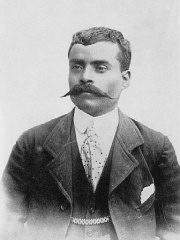
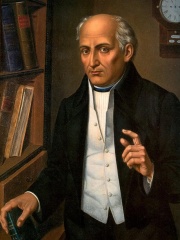
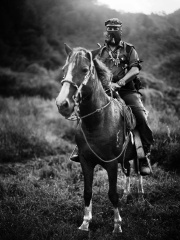
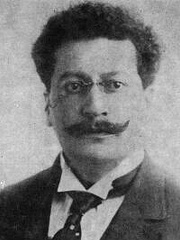
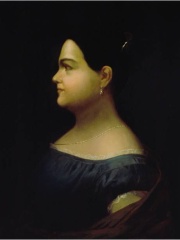
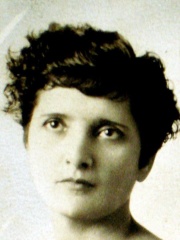
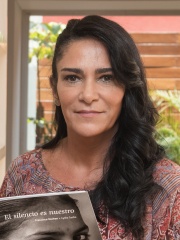

The Most Famous
SOCIAL ACTIVISTS from Mexico
This page contains a list of the greatest Mexican Social Activists. The pantheon dataset contains 840 Social Activists, 13 of which were born in Mexico. This makes Mexico the birth place of the 15th most number of Social Activists behind Poland, and Italy.
Top 10
The following people are considered by Pantheon to be the top 10 most legendary Mexican Social Activists of all time. This list of famous Mexican Social Activists is sorted by HPI (Historical Popularity Index), a metric that aggregates information on a biography's online popularity. Visit the rankings page to view the entire list of Mexican Social Activists.

1. Emiliano Zapata (1879 - 1919)
With an HPI of 75.75, Emiliano Zapata is the most famous Mexican Social Activist. His biography has been translated into 73 different languages on wikipedia.
Emiliano Zapata Salazar (Latin American Spanish: [emiˈljano saˈpata]; 8 August 1879 – 10 April 1919) was a Mexican revolutionary and guerrilla leader. He was a leading figure in the Mexican Revolution of 1910–1920, the main leader of the people's revolution in the Mexican state of Morelos, and the inspiration of the agrarian movement called Zapatismo. Zapata was born in the rural village of Anenecuilco, Morelos in an era when peasant communities came under increasing repression from the small-landowning class who monopolized land and water resources for sugarcane production with the support of dictator Porfirio Díaz (President from 1877 to 1880 and 1884 to 1911). Zapata early on participated in political movements against Díaz and the landowning hacendados, and when the Revolution broke out in 1910 he became a leader of the peasant revolt in Morelos. Cooperating with a number of other peasant leaders, he formed the Liberation Army of the South, of which he soon became the undisputed leader. Zapata's forces contributed to the fall of Díaz, defeating the Federal Army in the Battle of Cuautla in May 1911, but when the revolutionary leader Francisco I. Madero became president he disavowed the role of the Zapatistas, denouncing them as mere bandits. In November 1911, Zapata promulgated the Plan de Ayala, which called for substantial land reforms, redistributing lands to the peasants. Madero sent the Federal Army to root out the Zapatistas in Morelos. Madero's generals employed a scorched-earth policy, burning villages and forcibly removing their inhabitants, and drafting many men into the Army or sending them to forced-labor camps in southern Mexico. Such actions strengthened Zapata's standing among the peasants, and succeeded in driving the forces of Madero, led by Victoriano Huerta, out of Morelos. In a coup against Madero in February 1913, Huerta took power in Mexico, but a coalition of Constitutionalist forces in northern Mexico, led by Venustiano Carranza, Álvaro Obregón and Francisco "Pancho" Villa, ousted him in July 1914 with the support of Zapata's troops. Zapata did not recognize the authority that Carranza asserted as leader of the revolutionary movement, continuing his adherence to the Plan de Ayala. In the aftermath of the revolutionaries' victory over Huerta, they attempted to sort out power relations in the Convention of Aguascalientes (October to November 1914). Zapata and Villa broke with Carranza, and Mexico descended into a civil war among the winners. Dismayed with the alliance with Villa, Zapata focused his energies on rebuilding society in Morelos (which he now controlled), instituting the land reforms of the Plan de Ayala. As Carranza consolidated his power and defeated Villa in 1915, Zapata initiated guerrilla warfare against the Carrancistas, who in turn invaded Morelos, employing once again scorched-earth tactics to oust the Zapatista rebels. Zapata re-took Morelos in 1917 and held most of the state against Carranza's troops until he was killed in an ambush in April 1919. After his death, Zapatista generals aligned with Obregón against Carranza and helped drive Carranza from power. In 1920, Zapatistas obtained important positions in the government of Morelos after Carranza's fall, instituting many of the land reforms envisioned by Zapata. Zapata remains an iconic figure in Mexico, used both as a nationalist symbol as well as a symbol of the neo-Zapatista movement. Article 27 of the 1917 Mexican Constitution was drafted in response to Zapata's agrarian demands.

2. Miguel Hidalgo y Costilla (1753 - 1811)
With an HPI of 70.78, Miguel Hidalgo y Costilla is the 2nd most famous Mexican Social Activist. His biography has been translated into 56 different languages.
Don Miguel Gregorio Antonio Ignacio Hidalgo y Costilla Gallaga Mandarte y Villaseñor (8 May 1753 – 30 July 1811), commonly known as Miguel Hidalgo y Costilla or simply Miguel Hidalgo (Spanish: [miˈɣel iˈðalɣo]), was a Mexican Catholic priest and prominent leader of the Mexican War of Independence, who is recognized as the Father of the Nation. A professor at the Colegio de San Nicolás Obispo in Valladolid, Hidalgo was influenced by Enlightenment ideas, which contributed to his ouster in 1792. He served in a church in Colima and then in Dolores. After his arrival, he was shocked by the rich soil he had found. He tried to help the poor by showing them how to grow olives and grapes, but in New Spain (modern Mexico) growing these crops was discouraged or prohibited by colonial authorities to prevent competition with imports from Spain. On 16 September 1810, he gave the Cry of Dolores, a speech calling upon the people to protect the interest of King Ferdinand VII, held captive as part of the Peninsular War, by revolting against the peninsulares who had overthrown Viceroy José de Iturrigaray. Hidalgo marched across Mexico and gathered an army of nearly 90,000 irregulars who attacked peninsular and criollo elites. Hidalgo's insurgent army accumulated initial victories on its way to Mexico City, but his troops ultimately lacked training and were poorly armed. These troops ran into an army of well-trained and armed Spanish troops in the Battle of Calderón Bridge and were defeated. After the battle, Hidalgo and his remaining troops fled north, but Hidalgo was betrayed, captured and executed.

3. Subcomandante Marcos (b. 1957)
With an HPI of 64.94, Subcomandante Marcos is the 3rd most famous Mexican Social Activist. His biography has been translated into 37 different languages.
Rafael Sebastián Guillén Vicente (born 19 June 1957) is a Mexican insurgent, the former military leader and spokesman for the Zapatista Army of National Liberation (EZLN) in the ongoing Chiapas conflict, and a prominent anti-capitalist and anti-neoliberal. Widely known by his initial nom de guerre Subcomandante Insurgente Marcos (frequently shortened to simply Subcomandante Marcos), he has subsequently employed several other pseudonyms: he called himself Delegate Zero during the Other Campaign (2006–2007), Subcomandante Insurgente Galeano (again, frequently with the "Insurgente" omitted) from May 2014 to October 2023, which he adopted in honor of his fallen comrade Jose Luis Solis Lopez, his nom de guerre being Galeano, aka "Teacher Galeano." and since October 2023, Capitán Insurgente Marcos. Marcos bears the title and rank of Capitán (or "Captain" in English), and before that Subcomandante, (or "Subcommander" in English), as opposed to Comandante (or "Commander" in English), because he is under the command of the indigenous commanders who constitute the EZLN's Clandestine Revolutionary Indigenous Committee's General Command (CCRI-CG in Spanish). Born in Tampico, Tamaulipas, Marcos earned a degree from the Faculty of Philosophy and Literature at the National Autonomous University of Mexico (UNAM), and taught at the Autonomous Metropolitan University (UAM) for several years during the early 1980s. During this time he became increasingly involved with a guerrilla group known as the National Liberation Forces (FLN), before leaving the university and moving to Chiapas in 1984. The Ejército Zapatista de Liberación Nacional (EZLN) (Zapatista Army of National Liberation; often simply called the Zapatistas) was the local Chiapas wing of FLN, founded in the Lacandon Jungle in 1983, initially functioning as a self-defense unit dedicated to protecting Chiapas' Mayan people from evictions and encroachment on their land. While not Mayan himself, Marcos emerged as the group's military leader, and when the EZLN, acting independently of the FLN, began its rebellion on 1 January 1994, he served as its spokesman. Known for his trademark ski mask and pipe and for his charismatic personality, Marcos coordinated the EZLN's 1994 uprising, headed up the subsequent peace negotiations, and played a prominent role throughout the Zapatistas' struggle in the following decades. After the ceasefire the government declared on day 12 of the revolt, the Zapatistas transitioned from revolutionary guerrillas to an armed social movement, with Marcos's role transitioning from military strategist to public relations strategist. He became the Zapatistas' spokesperson and interface with the public, penning communiqués, holding press conferences, hosting gatherings, granting interviews, delivering speeches, devising plebiscites, organizing marches, orchestrating campaigns, and twice touring Mexico, all to attract national and international media attention and public support for the Zapatistas. In 2001, he headed a delegation of Zapatista commanders to Mexico City to deliver their message on promoting indigenous rights before the Mexican Congress, attracting widespread public and media attention. In 2006, Marcos made another public tour of Mexico, which was known as The Other Campaign. In May 2014, Marcos stated that the persona of Subcomandante Marcos had been "a hologram" and no longer existed. Many media outlets interpreted the message as Marcos retiring as the Zapatistas' military leader and spokesman. Marcos is a prolific writer whose considerable literary talents have been widely acknowledged by prominent writers and intellectuals, with hundreds of communiqués and several books being attributed to him. Most of his writings are anti-capitalist while advocating for indigenous people's rights, but he has also written poetry, children's stories, and folktales and co-authored a crime novel. He has been hailed by Régis Debray as "the best Latin American writer today." Published translations of his writings exist in at least 14 languages.

4. Ricardo Flores Magón (1874 - 1922)
With an HPI of 60.54, Ricardo Flores Magón is the 4th most famous Mexican Social Activist. His biography has been translated into 21 different languages.
Cipriano Ricardo Flores Magón (Spanish: [riˈkaɾðo ˈfloɾes maˈɣon]; known as Ricardo Flores Magón; September 16, 1874 – November 21, 1922) was a Mexican anarchist and social reform activist. His brothers Enrique and Jesús were also active in politics. Followers of the Flores Magón brothers were known as Magonistas. He has been considered an important participant in the social movement that sparked the Mexican Revolution.

5. Miriam Rodríguez Martínez (1967 - 2017)
With an HPI of 60.41, Miriam Rodríguez Martínez is the 5th most famous Mexican Social Activist. Her biography has been translated into 30 different languages.
Miriam Elizabeth Rodríguez Martínez (5 February 1960 – 10 May 2017) was a Mexican human rights activist. She became one of the many "Missing Child Parents", (a class of victims of organized crime, labeled as such by local news media) after her daughter was abducted and killed. On 10 May, 2017, Rodríguez was shot dead by gunmen who had broken into her home.

6. Leona Vicario (1789 - 1842)
With an HPI of 57.63, Leona Vicario is the 6th most famous Mexican Social Activist. Her biography has been translated into 17 different languages.
María de la Soledad Leona Camila Vicario Fernández de San Salvador, best known as Leona Vicario (April 10, 1789 – August 21, 1842), was one of the most prominent figures of the Mexican War of Independence. She was dedicated to informing insurgents of movements in her home Mexico City, the capital of the viceroyalty. She was a member of Los Guadalupes, one of the earliest independence movements in New Spain. She financed the rebellion with her large fortune. She was one of the first female journalists in Mexico. She reportedly took many risks and sacrificed much wealth in the name of liberation. Vicario has been given the title "Distinguished and Beloved Mother of the Homeland" by the Congress of the Union. Her name is inscribed in gold in the Mural of Honor in the lower house of the Mexican Congress. 2020 was declared the "Year of Leona Vicario, Benemérita (Praiseworthy) Madre (Mother) de la Patria (of the Motherland).

7. Elvia Carrillo Puerto (1878 - 1968)
With an HPI of 53.44, Elvia Carrillo Puerto is the 7th most famous Mexican Social Activist. Her biography has been translated into 16 different languages.
Elvia Carrillo Puerto (30 January 1881 – 18 April 1965) was a Mexican socialist politician and feminist activist. She is known for her work with various feminist organizations and for her attempts to run for office in Yucatán and San Luis Potosí. Some refer to her as "The Red Nun of the Mayab". Carrillo was born to a middle-class family in Motul, Yucatán. She became politically active by 1910, when she served as a courier and spy in the Valladolid Rebellion against dictator Porfirio Díaz and his favored candidate in the 1909 Yucatán gubernatorial election, Enrique Muñoz Arístegui. She founded the Rita Cetina Gutiérrez Feminst League in 1919, which advocated for birth control and literacy for rural women. In 1923, she was elected to the Yucatán legislature but fled during political unrest following the assassination of her brother, Yucatán Governor Felipe Carrillo Puerto. She also campaigned to become a deputy in San Luis Potosí's fourth district. Despite winning the popular vote, her victory was overturned on the grounds that women were ineligible for office. In the late 1920s and 1930s, Elvia Carrillo Puerto advocated for women's suffrage and labor rights by organizing national conferences and working with feminist organizations such as the Sole Front for Women's Rights (Spanish: Frente Único Pro Derechos de la Mujer, FUPDM). However, she experienced financial hardship later in life and ultimately died of bronchopneumonia in Mexico City in 1965. The Mexican Senate established the Elvia Carrillo Puerto medal in 2013 to honor women advocating for gender equality and women's rights, and she has been commemorated with several statues. She is recognized for her pivotal role in advancing women's rights and women's suffrage in Mexico.

8. Lydia Cacho (b. 1963)
With an HPI of 49.55, Lydia Cacho is the 8th most famous Mexican Social Activist. Her biography has been translated into 23 different languages.
Lydia María Cacho Ribeiro (born 12 April 1963) is a Mexican journalist, feminist, and human rights activist. Described by Amnesty International as "perhaps Mexico's most famous investigative journalist and women's rights advocate", Cacho's reporting focuses on violence against and sexual abuse of women and children. Her book Los Demonios del Edén (in English: The Demons of Eden) (2004) created a nationwide scandal by alleging that several prominent businessmen had conspired to protect a pedophilia ring. In 2006, a tape emerged of a conversation between businessman Kamel Nacif Borge and Mario Plutarco Marín Torres, governor of Puebla, in which they conspired to have Cacho beaten and raped for her reporting. Marín Torres was arrested for the alleged torture on 3 February 2021. Cacho is the winner of numerous international awards for her journalism, including the Civil Courage Prize, the Wallenberg Medal, and the Olof Palme Prize. In 2010, she was named a World Press Freedom Hero of the International Press Institute.

9. Leydy Pech (b. 1965)
With an HPI of 46.09, Leydy Pech is the 9th most famous Mexican Social Activist. Her biography has been translated into 19 different languages.
Leydy Araceli Pech Marín, known as Leydy Pech, (born 1965) is a Mexican beekeeper and environmental activist of Mayan origin. She was awarded the Goldman Environmental Prize in 2020 for her work against the planting of transgenic soybeans in the Yucatán Peninsula.

10. Susana Chávez (1974 - 2011)
With an HPI of 45.80, Susana Chávez is the 10th most famous Mexican Social Activist. Her biography has been translated into 15 different languages.
Susana Chávez Castillo (November 5, 1974 – c. January 6, 2011) was a Mexican poet and human rights activist who was born and lived most of her life in her hometown of Ciudad Juárez. She is credited with the authorship of the phrase "Not one more" (Spanish: Ni una muerta más), which was used by the civil rights organizations and their supporters struggling to address the plight of women in Juárez and to end a wave of killings aimed specifically at women since 1993. She was found murdered and mutilated in the "Colonia Cuauhtémoc" section of the city of Juárez where she was born and lived most of her life. Positive identification of the remains took place on January 11, 2011. She was 36 years old.
People
Pantheon has 13 people classified as Mexican social activists born between 1753 and 2002. Of these 13, 5 (38.46%) of them are still alive today. The most famous living Mexican social activists include Subcomandante Marcos, Lydia Cacho, and Leydy Pech. The most famous deceased Mexican social activists include Emiliano Zapata, Miguel Hidalgo y Costilla, and Ricardo Flores Magón. As of April 2024, 2 new Mexican social activists have been added to Pantheon including Susana Chávez, and María Fernanda Castro Maya.
Living Mexican Social Activists
Go to all RankingsSubcomandante Marcos
1957 - Present
HPI: 64.94
Lydia Cacho
1963 - Present
HPI: 49.55
Leydy Pech
1965 - Present
HPI: 46.09
Xiye Bastida
2002 - Present
HPI: 40.38
María Fernanda Castro Maya
HPI: 38.06
Deceased Mexican Social Activists
Go to all RankingsEmiliano Zapata
1879 - 1919
HPI: 75.75
Miguel Hidalgo y Costilla
1753 - 1811
HPI: 70.78
Ricardo Flores Magón
1874 - 1922
HPI: 60.54
Miriam Rodríguez Martínez
1967 - 2017
HPI: 60.41
Leona Vicario
1789 - 1842
HPI: 57.63
Elvia Carrillo Puerto
1878 - 1968
HPI: 53.44
Susana Chávez
1974 - 2011
HPI: 45.80
Guadalupe Campanur Tapia
1986 - 2018
HPI: 36.49
Newly Added Mexican Social Activists (2025)
Go to all RankingsOverlapping Lives
Which Social Activists were alive at the same time? This visualization shows the lifespans of the 7 most globally memorable Social Activists since 1700.




